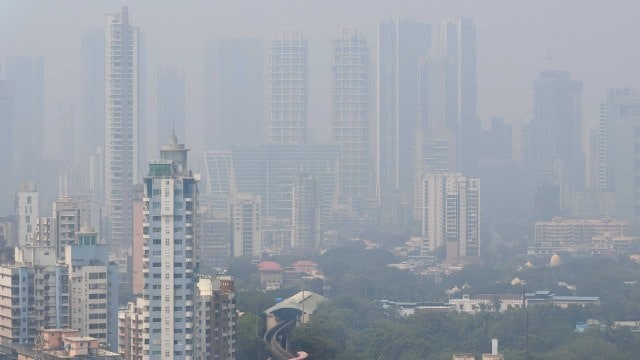No respite for Mumbai from rising AQI levels even as Cyclone Tej develops
According to scientists, Cyclone Tej is headed in the northwesterly direction ringing in rain activity in Yemen, owing to which Mumbai as well as the entire west coast is slated to receive no rainfall even after the cyclone's complete development.
 On the question of the worsening air quality, Bhagwan Kesbhat, CEO of Waatavaran Foundation said that the civic body needs to take serious interventions to combat the issue. (Express Photo by Amit Chakravarty)
On the question of the worsening air quality, Bhagwan Kesbhat, CEO of Waatavaran Foundation said that the civic body needs to take serious interventions to combat the issue. (Express Photo by Amit Chakravarty) Even as a light drizzle swept pockets of Mumbai Metropolitan Region on Friday afternoon and Cyclone Tej is slated to develop over the next 24 hours, the India Meteorological Department (IMD) said the city can expect no respite from the rising AQI levels.
According to scientists, Cyclone Tej is headed in the northwesterly direction ringing in rain activity in Yemen, owing to which Mumbai as well as the entire west coast is slated to receive no rainfall even after the cyclone’s complete development.
Sushma Nair told The Indian Express, “Currently, Cyclone Tej has formed a deep depression and within the next 24 hours, it will develop completely. However, the cyclone is slated to bring activity in Yemen and if it travels, then, it will result in developments in Oman. It must be noted that Cyclone Tej is nowhere near the west coast owing to which neither Mumbai nor any other parts of the country will receive showers because of this cyclone. The AQI levels could have gone down had there been any rain activity. But now, the AQI will remain unaffected.”
Read Death By Breath Series – Mumbai holds its breath | Why construction dust is lethal | BMC’s rulebook gets a burial
A mere two weeks after the withdrawal of monsoon, Mumbai has been reeling under burgeoning AQI levels as well as high temperatures in the ongoing week. While the average AQI on Monday touched 184 in Mumbai, on Wednesday, as the city’s temperature soared to a four-year high for October, levels of PM10 — Particulate Matter. A day earlier, Mumbai’s overall AQI touched 191, way worse than Delhi’s 84.
Responding to questions from Express, Nair explained, “Currently, the wind circulation has been such that the air couldn’t rise because of which dust particles remained suspended in the air resulting in rising AQI levels.”
Meanwhile, Mahesh Palawat from Skymet Weather Services added that dust from construction sites, dry weather, high temperatures and lack of winds have resulted in the increased AQI levels in the city, post monsoon withdrawal.
On Friday, pockets of Mumbai Metropolitan Region experienced light drizzle which meteorologists as well as weather experts attributed to a trough in the north coast of Maharashtra. Despite the showers, they maintained that the AQI level will not witness a decline.
Speaking to The Indian Express, Palawat said, “There is a small trough in the north coast of Maharashtra which may bring light rain but it won’t prevail. The AQI levels in the city are not slated to drop unless there is prolonged rain activity. The current spells have no connection to Cyclone Tej as it is far away in the east-central Arabian Sea.”
On the question of the worsening air quality, Bhagwan Kesbhat, CEO of Waatavaran Foundation said that the civic body needs to take serious interventions to combat the issue.
“Construction and other demolition works generate PM 10 in the air which causes major breathing issues amongst people, especially children and the elderly. Following the withdrawal of monsoon, the moisture levels remain high while temperatures dip in the night, the dust particles cannot be suppressed and remain suspended in the air. The BMC needs to come with serious, long term solutions unlike the smog guns which only settles down the dust temporarily,” said Kesbhat







